Home | Category: Literature and Drama
The ODYSSEY
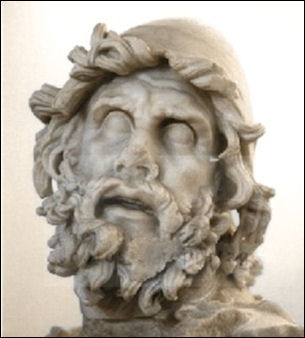
Odysseus The “Odyssey” is the tale of Odysseus's journey home after the Trojan War. Attributed to Homer, who lived around 850 B.C., it is very different from Homer's other book,the “ Iliad”. Rather than being about battles and brave warriors who use their power and strength to take matters into their own hands it is about a single warrior whose power and strength are no match against the whims and capriciousness of the gods and who must learn to deal with a fate over which he has no control. Much of The “ Odyssey” is about setback and delays. The crew is often complaining about something and Odysseus is not great fan of the open sea.
Like the "Iliad," the "Odyssey" was also probably not written down until long after the death of Homer. The poem, which relates events of the twelfth century B.C., is thought to have been composed in the eighth century B.C. and was first written down in the sixth century B.C. One of the earliest surviving copies of the "Odyssey" is a fragment of the text that appears on a fifth century B.C. pottery shard found at Olbia in modern-day Ukraine.
Juan Piquero wrote in National Geographic: Although it was written down centuries later, The Odyssey is set in Mycenaean Greece during the middle of the Bronze Age, between 1600 and 1200 B.C. Historians believe that The Odyssey incorporates earlier oral traditions from that period while reflecting the cultural norms of Homer’s era. There are still some insights to be gleaned about life during the Mycenaean period or just after through Odysseus’ travels, making it not only a thrilling trickster tale but also an important historical snapshot. [Source: Juan Piquero, National Geographic, April 13, 2023]
The main places in the odyssey were: 1) Ithaca: island on which the kingdom of Laertes, of which Odysseus was king, was located; 2) Ogygia, the island on which Calypso lived; 2) Aeaea: island on which Circe lived, and later Penelope and Telemachus; 3) Sparta, kingdom of Menelaus (son of Atreus and Aerope) and Helen; 4) Scherie, the island on which the Phaeacians lived.
RELATED ARTICLES:
REAL PLACES IN THE ODYSSEY, JAMES JOYCE AND THE SEARCH OF ODYSSEUS'S ITHACA europe.factsanddetails.com
HOMER: HIS WORKS, HYMNS AND STYLE europe.factsanddetails.com ;
HOMER'S TAKE ON TOPICS LIKE FOOD, SACRIFICES AND HADES europe.factsanddetails.com ;
RHAPSODES: THE SINGING BARDS OF HOMERIC-ERA AND CLASSICAL GREECE europe.factsanddetails.com ;
ILIAD: PLOT, CHARACTERS, BATTLES, FIGHTING europe.factsanddetails.com
Websites on Ancient Greece: Internet Ancient History Sourcebook: Greece sourcebooks.fordham.edu ; Hellenistic World sourcebooks.fordham.edu ; Lives and Social Culture of Ancient Greece, Maryville University online.maryville.edu ; BBC Ancient Greeks bbc.co.uk/history/; Perseus Project - Tufts University; perseus.tufts.edu ; ; Gutenberg.org gutenberg.org; British Museum ancientgreece.co.uk; Illustrated Greek History, Dr. Janice Siegel, Hampden–Sydney College hsc.edu/drjclassics ; Cambridge Classics External Gateway to Humanities Resources web.archive.org/web; Ancient Greek Sites on the Web from Medea showgate.com/medea ; Greek History Course from Reed web.archive.org; Classics FAQ MIT classics.mit.edu
RECOMMENDED BOOKS:
“Odyssey” by Homer translated by Stanley Lombardo is regarded as one of the most accessible translations Amazon.com;
“Odyssey” by Homer translated by Robert Fagles is also supposed to be good Amazon.com;
“The World of Odysseus” by M.I. Finley (1912-1986) Amazon.com;
“The Iliad And The Odyssey of Homer” by Homer Amazon.com;
“Ulysses” by James Joyce, a modernist, 20th century interpretation of “The Odyssey” Amazon.com;
“Argus: Dog of Ancient Greece” by J. Sepúlveda (2015), Argus was Odysseus’s dog Amazon.com;
“Monsters in Greek Literature: Aberrant Bodies in Ancient Greek Cosmogony, Ethnography, and Biology” by Fiona Mitchell (2021) Amazon.com;
“Circe” by Madeline Miller (2018), Novel Amazon.com;
“Odysseus Unbound: The Search for Homer's Ithaca” by Robert Bittlestone, James Diggle, et al. (2005) Amazon.com;
“Odysseus' Island” by Jane Cochrane (2019) Amazon.com;
“Walking in the Footsteps of Odysseus: A Practical Guide to the Homeric Paths of Ithaca”
by Jane Cochrane (2022) Amazon.com;
“In Search of Homeric Ithaca” by Jonathan Brown (2020) Amazon.com;
Plot of the Odyssey
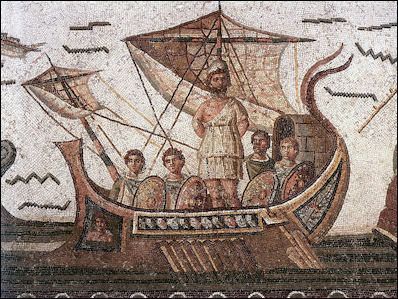 The Odyssey begins years after the fall of Troy. On the island of Ithaca, Odysseus’s wife Penelope and his son Telemachus wait for Odysseus’ return. During the 20 years that Odysseus has been gone (10 years in Troy and 10 years at sea) Penelope had been approached by many suitors, who presume Odysseus is dead and are hoping to marry her and rule Ithaca. To keep suitors away until Odysseus returned she told them that she would make her herself available after she finished the garment she was weaving — funeral shroud for Odysseus’ father, Laertes — which she would secretly unravel every night. Telemachus, encouraged by the goddess Athena, searches for his father, much to the displeasure of the suitors.
The Odyssey begins years after the fall of Troy. On the island of Ithaca, Odysseus’s wife Penelope and his son Telemachus wait for Odysseus’ return. During the 20 years that Odysseus has been gone (10 years in Troy and 10 years at sea) Penelope had been approached by many suitors, who presume Odysseus is dead and are hoping to marry her and rule Ithaca. To keep suitors away until Odysseus returned she told them that she would make her herself available after she finished the garment she was weaving — funeral shroud for Odysseus’ father, Laertes — which she would secretly unravel every night. Telemachus, encouraged by the goddess Athena, searches for his father, much to the displeasure of the suitors.
After leaving his native Ithaca to fight in the Trojan War, Odysseus goes on an adventurous, journey home, according to Homer's "The Odyssey." Odysseus famously took 10 years to return home to Ithaca after the fall of Troy. On his journey, he was twice shipwrecked and encountered a cyclops, the spirit of his mother and withstands the deadly, tempting sirens’ song.Odysseus escapes numerous perils, including the cannibalistic Laestrygonians and the sorceress Circe, who turns his men into pigs. He takes a trip to the underworldand navigates the treacherous waters between the monsters Scylla and Charybdis. Along the way, his fleet wrecks, and his men are lost.
Juan Piquero wrote in National Geographic: Odysseus spent seven years waylaid on a nymph’s island. The immortal Calypso is in love with him and will not let him go, but Odysseus continues to long for home. The gods intercede and command her to release him. He sets out on a raft and reaches the island of the Phaeacians, to whom he reveals his true identity and tells the story of his 10-year voyage since the end of the Trojan War. [Source: Juan Piquero, National Geographic, April 13, 2023]
Finally Odysseus makes it home to Ithaca, where he finds his wife, Penelope, under pressure to remarry from a host of suitors who have invaded the royal palace. With the help of his father, Laertes, and his son, Telemachus, he slaughters his rivals and re-establishes his rule.
The first four books of the Odyssey describe Odysseus's unhappy son Telemachus home on the island of Ithaca on the west side of Greece. The eight books that follow describe Odysseus's travels (these include the the Voyage to Hades and encounters with Circe, Scylla, Charybdis, the Sirens, the Lotus Eaters, the Cyclops, the Wander Rocks and others. The final twelve chapters describe Odysseus' homecoming and the reclamation of his kingdom.
Main Characters in the Odyssey
Odysseus, son of Laertes and Antikleia, was King of Ithaca. He participated in the Trojan War for 10 years; his return journey from Troy to Ithaca took an additional 10 years. He was also a character in Sophocles' Philoctetes. [Source: John Adams, California State University, Northridge (CSUN), “Classics 315: Greek and Roman Mythology class ++]
Penelope, the faithful wife of Odysseus, was daughter of Icarius (King of Sparta) and the Naiad Periboea. Her children were Telemachos and Acusilaus. After Odysseus' death at the hands of his son Telegonus (by the sorceress Circe), Penelope married Telegonus. They are said to have had a son called Italos. ++
Telemachos, son of Odysseus and Penelope, helped his father to destroy the suitors. On Odysseus' death he went with Penelope to the island of Aeaea, where he married Circe. Circe made Telemachus and Penelope immortal. ++
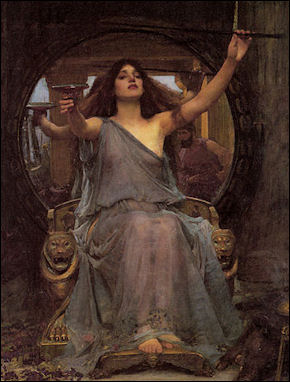
Circe Offering the Cup
to Odysseus Eumaios, son of Ctesias, son of Ormenos (king of the island of Syria), was kidnaped by Phoenician pirates and sold to King Laertes of Ithaca. He was chief Swineherd to Odysseus (Books XIV & XVI). Faithful to the end, he helps Odysseus to defeat the villainous suitors. Melanthios was son of Dolios, chief goatherd of Odysseus. He took the side of the suitors, and supplied them with weapons to use against Odysseus He was trapped, mutilated and left to die (XVII, XXII). AEurycleia A, Odysseus’ old nurse, sees through his disguise and recognizes a childhood scar as she washes his feet.
++
Antinoos , son of Eupaithes (whose life Odysseus had once saved), was the most insolent of the suitors of Penelope, and was killed by Odysseus. Eupeithes raised a revolt against Odysseus, but was killed by Laertes. Eurymachos , son of Polybos, a leading suitor for Penelope, was the second to be killed. ++
Teiresias, the dead Theban soothsayer (son of one of the Spartoi), he tells Odysseus about his future in Book XI (the Nekyia). Alcinoos was son of Nausithoos and king of the Phaeacians. He married his brother's daughter Arete. They had five sons and a daughter. In the previous generation he protected Jason and Medea against the Colchians (Book V-XIII). Nausicaa , daughter of Alcinoos and Arete. Her help allowed Odysseus to win the favor of King Alcinoos, and her hand was offered to Odysseus. ++
Gods in the Odyssey
Circe was the daughter of Helios and of Perse (daughter of Oceanos). Her brother Aeetes ruled Colchis. She turned Picus into a woodpecker; gave Glaucus a potion that turned his beloved Scylla into a monster; and turned Odysseus' men into pigs (Books X & XII). [Source: John Adams, California State University, Northridge (CSUN), “Classics 315: Greek and Roman Mythology class ++]
Calypso, a goddess (or nymph), was the daughter of Atlas the Titan, son of Iphitos and Clymene — and thus, a niece of Prometheus and cousin of Maia, Hermes' mother. She lived alone on the island of Ogygia. She detained Odysseus for seven years, and offered to make him immortal; but at the command of Zeus sent by Hermes, he was allowed to leave (Book V and VII)
Polyphemus, the son of Poseidon and the sea-nymph Thoosa, was reputedly one of the Cyclopes. He was a barbarous Sicilian sheepherder (Book IX, and Ovid's Metamorphoses 13. 738-897), blinded by Odysseus. His prayers to Poseidon kept Odysseus from returning to Ithaca for ten years.
The ancient Greeks believed that their gods and goddesses would protect them and guide them if they were treated properly. A key element of this was worshipping the gods by carrying out ceremonies and sacrifices. The Greeks worshiped their gods to affect their fate while living and secure a relatively good place in the afterlife.
Odysseus
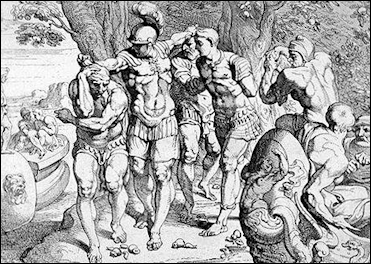
Lotus Eaters Odysseus (Ulysses to the Romans) was a Greek king from Ithaca who fought in the Trojan War against the Trojans on the side of Achilles and the Greeks. He was the cleverest of the warriors in the “ Iliad” and is credited with coming up with the idea of the Trojan horse. The name Odysseus is linked to the Greek verb “ odussomai” , which means “to suffer pain.”
Odysseus was the kind of man women romanticize about (he was faithful, after all, for 20 years). He did not want to go to Troy to fight the war there and tried many tricks, including pretending he was mad by plowing a beach instead of a field, to get out of going but none of these tricks worked , and he was reluctantly forced to say good by to his wife Penelope and his son Telemachus.
When the war was over Odysseus set sail from Troy with 12 ships and a treasure taken from the Trojans. By this time he had been away from family for ten years already. A journey that should have taken several weeks ended up taking more than ten years as a result of delays brought about by monsters, enchantresses and foul weather.
Juan Piquero wrote in National Geographic: From Anansi, the spider of West African folklore, to Loki, the shape-shifter of Norse mythology, tricksters are some of the most entertaining characters in stories all over the world. Neither the strongest, the fleetest, nor the best looking, the tricksters triumph through their brains, not their brawn. One of the world’s oldest and best known is Odysseus, whose quick thinking gets him out of one predicament after another in The Odyssey, a circa eighth-century B.C. epic attributed to the Greek poet Homer. [Source: Juan Piquero, National Geographic, April 13, 2023]
Odysseus first appears in another work attributed to Homer, The Iliad, which tells the story of a feud between Achilles and Agamemnon during the 10-year war between the Greeks and Trojans. The king of Ithaca, Odysseus fights for the Greeks. The Odyssey recounts his return home to his kingdom, wife Penelope, and son Telemachus. The voyage should have taken days, but instead it stretches across a decade because Odysseus has drawn the ire of Poseidon, god of the sea. Time after time, the enraged god thwarts Odysseus’ progress, yet the wily trickster manages to survive again and again.
Odysseus, the Lotus Eaters and the Cyclops
A short time after leaving from Troy, a great storm blew Odysseus's ships off course to the Land of the Lotus Eaters, where several of his men ate lotus fruit and from then on could think of nothing but eating lotus fruit. They lost their desire to go home and Odysseus had to drag them back to the ship.
After rescuing these men Odysseus landed next in the Land of the one-eyed giants, Cyclops, where he and some of his men were trapped in a cave by a Cyclops named Polyphemus, who was angry at some of Odysseus’s men because they ate some of his food and was no great lover of mankind anyway. Six of Odysseus’s men were eaten but Odysseus and the others escaped after Odysseus got the Cyclops drunk and gouged out his eye and he and his men escaped by clinging onto the underbelly of a ram. On the eye-gouging, Homer wrote: “’I drove my weight on it from above and bored it home like a shipwright bores his beam with a shipwright's drill that men below, whipping the strap back and forth, whirl and the drill keeps twisting, never stopping — So we seized our stake with its fiery tip and bored it round and round in the giant's eye.’”
John Burbery wrote:“The Cyclopes, the tribe of one-eyed ogres that terrorized Odysseus and his crew, might have sprung from the findings of prehistoric elephant skulls in Greece and Italy. In 1914, paleontologist Othenio Abel pointed out that these fossils feature large facial cavities in front, from which the trunk would have protruded. The eye sockets, by contrast, are easily overlooked on the sides of the cranium. To the ancient Greeks who dug them up, these skulls might have seemed like the remains of monocular, humanoid giants. [Source: Timothy John Burbery, Professor of English, Marshall University, The Conversation, January 10, 2022]
Odysseus taunts the enraged Polyphemus and tell him his name. The Cyclops then prays to his father, the god Poseidon, to curse the king and force him to wander for 10 years. Afterwards Odysseus and his men meet up with Aeolus, the wind god, who gives Odysseus a favorable wind to reach home and bag with other winds. When Ithaca was in sight Odysseus fell asleep. His men thought the bag was full of treasures and opened it, releasing winds that blew them away from Ithaca.
Odysseus, the Laestrygonians, Circe and the Sirens
Odysseus next landed in the Land of the Laestrygonians, giant women who were "more than men they seemed,/ gigantic when they gathered on the sky line/ to shoot great boulders down from slings." Their giant queen ate of number of Odysseus’s men, and her warriors threw boulders at Odysseus's ships, sinking 11 of them. Only Odysseus's ship and his men managed to escape.
Next Odysseus landed on a friendly island ruled by the goddess Circe, who later became irritated by Odysseus' men and turned them into pigs. She tried to turn Odysseus into a pig too but her magic didn’t work on him because he had eaten a special flower given to him by Hermes. With the help of the gods Odysseus was able to get his men turned back into humans.
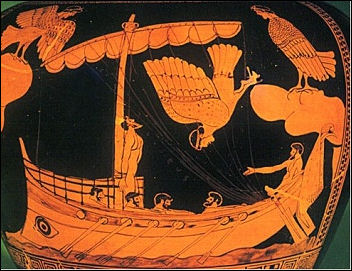
Odysseus and the Sirens Odysseus spent a half year in bed with Circe until he became overcome with guilt about his wife. Circe told Odysseus that he if he wanted to make it home, the gods insisted that he promise never to kill any of the sun god's sheep and make a short visit to Hades. He and his men survived their short visit there and Circe filled a boat with provisions and they returned to sea.
In Hades, Odysseus met his mother. Describing Odysseus’s encounter with his mother there, Home wrote: “I tried to find some way of embracing my poor mother’s ghost. Thrice I sprung towards her and tried to grasp her in my arms, but each time she flitted from my embrace as it were a dream or phantom.” When Odysseus asked his mother why she didn’t try to embrace him she explained: “All the people are like this when they are dead. The sinews no longer hold the flesh and bones together, these perish in the in the fierceness of consuming fire as soon as life has left the body, and the soul flirts away as though it were a dream.”
The encounter of Odysseus and his men with the Sirens, humanlike female beings with alluring voices, at sea was one of the main events in the Odyssey. Odysseus had been warned about the Sirens by Circe so he knew what to do when he met up with them. He had himself tied to a mast so he could resist the sirens’ tempting song. His crew stuffed wax in their ears. If a man could resist the sirens's call, tradition stated, a siren had to die and she dutifully dived to her death into the sea.
Odysseus, Scylla and Calypso
There next test was the whirlpool ("Three times/ from dawn to dusk she appears...a whirling maelstrom") created by the sucking of the monster Charybdid. Once through that Odysseus encountered the six-headed, twelve-tentacled monster Scylla. No ship had ever made it past them before. Scylla snatched six sailors but Odysseus and the others escaped.
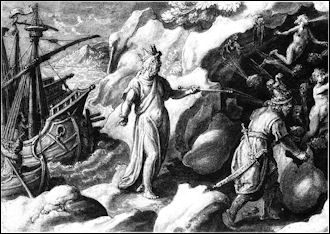
Odysseus in the Cave of the Winds Odysseus and arrived on the Sun God's island, where he broke his vow about killing the sheep to keep from starving. The vengeful sun god then sunk all of Odysseus' ships and all of his surviving men died. Odysseus escaped after floating for 10 days at sea and washing ashore on the paradise island occupied by the enchantress Calypso.
Calypso lived alone on the island and took no time in seducing Odysseus and then held him hostage for seven years. With the help of the gods, who were touched by Odysseus's homesickness, he was finally able to escape from Calypso on a raft. He floated for days and encountered a few more scrapes and close calls before he was able to make it home to Ithaca.
Moved by his story, the Phaeacians deliver Odysseus to Ithaca, where he: after so long a wait and so much pain, was filled with happiness at last. In joy he kissed the fertile earth of his own country, then lifted high his arms and prayed...
Odysseus Returns Home to Ithaca
When Odysseus returned to Ithaca he took up residence in a cave and pretended to be a beggar so he could assess what had happened on his island before claiming his throne. While staying at a swinwherd’s hut, Odysseus revealed himself to his son, Telemachus and together they plotted Odysseus’s return.
The following day, disguised with the help of Athena, Odysseus showed up at his palace. The ruse fools almost everyone, except for Odysseus’ loyal dog, Argos, who has been waiting for his master’s return: Twenty years had passed since Argos saw Odysseus, and now he saw him for the final time — then suddenly, black death took hold of him.
In the meantime, Penelope had run out of delaying tactics and was forced to chose a new husband. She said she would marry the man who could string Odysseus’s bow, which required great strength, and fire a quiver of arrows and throw an ax through the hole in 12 axes set in a row.
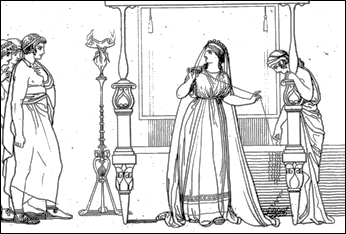
Penelope suitors All the suitors tried but couldn’t even string the bow. The disguised Odysseus approached and asked if he could try. All the suitors laughed: How could a beggar perform these tasks? Odysseus took the bow and strung it with ease. He then threw the ax through the hole and used the arrows to massacre all the suitors. “Ghastly screams rose up as men’s heads were smashed, and the whole floor ran with blood.” In the end corpses were piled “like fishes the fishermen have dragged out of the grey surf in he meshes of their net onto a curving beach, to lie massed on the sand longing for the salt water till the bright sun ends their lives.” Finally Odysseus was reunited with Penelope and claimed his throne and Penelope’s humiliations were avenged.
In July 2008, a team lead by Marcelo Magnsco of Rockefeller University in New York reported in the Proceedings of the National Academy of Science that according to the “Odyssey” Odysseus returned to his hometown on April 16, 1178 B.C. based on sun and star positions. Homer reported that on the day of Odysseus’s return, the day he slaughtered the suitors of his wife, the sun was blotted from the sky, a possible reference to an eclipse and mentioned more than once it was time a new moon, which is necessary for such an eclipse. Other clues included: 1) six days before the slaughter Venus is visible and high in the sky; 2) twenty-nine days before two constellations — the Pleiades and Bootes — are simultaneous visible at sunset; and 3) thirty-three days before Mercury is high at dawn and near the western end of its trajectory. The later is an interpretation by researchers of Homer writing about Hermes, the Greek name for Mercury, traveling to the West to deliver a message. The other references are firmer but still shaky.
Image Sources: Wikimedia Commons, The Louvre, The British Museum
Text Sources: Internet Ancient History Sourcebook: Greece sourcebooks.fordham.edu ; Internet Ancient History Sourcebook: Hellenistic World sourcebooks.fordham.edu ; BBC Ancient Greeks bbc.co.uk/history/; Canadian Museum of History, Perseus Project - Tufts University; perseus.tufts.edu ; MIT Classics Online classics.mit.edu ; Gutenberg.org, Metropolitan Museum of Art, National Geographic, Smithsonian magazine, New York Times, Washington Post, Live Science, Discover magazine, Natural History magazine, Archaeology magazine, The New Yorker, Encyclopædia Britannica, "The Discoverers" and "The Creators" by Daniel Boorstin. "Greek and Roman Life" by Ian Jenkins from the British Museum, Wikipedia, Reuters, Associated Press, The Guardian, AFP and various books and other publications.
Last updated September 2024
